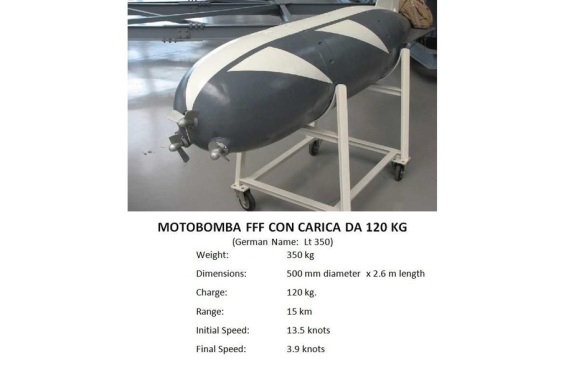
The Motabomba, or more properly the Motobomba FFF (Freri Fiore Filpa), was a torpedo used by Italian forces during World War II. The designation FFF was derived from the last names the three men involved with its original design: Lieutenant-Colonel Prospero Freri, Captain-Disegnatore Filpa, and Colonel Amedeo Fiore.
The FFF was a 500 millimetres (20 in) diameter electric torpedo which was dropped on a parachute and was designed to steer concentric spirals of between 550 and 4,375 yards (500 and 4,000 m) until it found a target. It weighed 350 kilograms (770 lb), and contained a 120 kilograms (260 lb) warhead. Its speed was 40 knots (46 mph) and it had an endurance of 15–30 minutes. It was acknowledged by the Germans as superior to anything they had and American intelligence was eager to get its hands on it after the Armistice with Italy in September 1943.
Development
The initial development work on the torpedo was carried out at Parioli, near Rome. It was demonstrated in 1935 to Benito Mussolini, Admiral Domenico Cavagnari, General Giuseppe Valle and other high officials. Freri later demonstrated it at the Germania works at Travemünde, the Luftwaffe experimental trials centre, and the Germans were sufficiently impressed to order 2,000 examples.
500 were ordered for the Regia Aeronautica, the first planned uses for them in combat to be against the British naval bases at Gibraltar and Alexandria in 1940. The limiting factor was the fact that only the Savoia-Marchetti SM.82 bomber had the necessary power and range to deliver such a weapon over such a distance.
The first version of the FFF were designed to enter the water vertically, but it was found that a tilt device allowing it to make a gentler angled entry was less likely to upset the delicate mechanisms, and this was implemented on the second series.
Service history
The first attack using the FFF was made on July 17, 1942 when three SM.82s flew from Guidonia against Gibraltar, an effort repeated on July 25, both missions aborted before launch. On the night of August 20, a Major Lucchini conducted a successful mission against Gibraltar and this was followed by attacks on targets in Albanian, Libyan, and Egyptian waters. Aircraft of 32 Stormo attacked Gibraltar once more in June 1941 and in that same month Lieutenant Torelli (based at Rhodes) attacked Alexandria harbour on the night of June 13.
The largest use of the weapon was against the PEDESTAL convoy to Malta on August 12, 1942 when ten Savoia-Marchetti SM.84s of 38 Gruppe’s 32 Stormo launched them against the convoy south of Cape Spartivento, Sardinia. This made the ships of the convoy alter course, which allowed conventional attacks to penetrate the convoy’s defences.
By September 1942 the Italians had 80 of the improved Mk 2 version at bases in Sardinia, 50 in Sicily, and 50 more with their experimental (ASI) 5 Squadron.
The Luftwaffe made their first mass attack using the weapon on March 19, 1943 when Junkers Ju 88s launched 72 of them against shipping at Tripoli, sinking two supply ships and damaging the destroyer HMS Derwent. Derwent was subsequently beached with her engine room flooded and although salvaged and returned to England, was never repaired.
The FFF was subsequently used in attacks against invasion shipping at Bône in Algeria on April 16, 1943 and at Syracuse during the Allied invasion of Sicily later that year. On December 2 a force of 105 Ju 88s attacked Bari harbour with FFFs, destroying 16 Allied ships including the SS John Harvey, which had been carrying mustard gas.
Bibliography
Giuseppe Ciampaglia: “La sorprendente storia della motobomba FFF”. Rivista Italiana Difesa. Luglio 1999
Motobomba FFF
The first Italian bombers appeared on Gibraltar in 17 of July, 1940. three SM 82 Marsupiale dropped each 4 250 kg high explosive bombs on the harbour( not in the sea) that was not darkened because none in the British Empire knew the performances of this three-engine aircraft yet ( 4000 km autonomy, 4000 kg bomb load).The British night fighters didn’t succeed in striking the raiders.
Bombs on the sea? Maybe you are right, but some weapons MUST be dropped in the sea.
In July/august 1940 and in June 1941 the SM 82s bombed Gibraltar 4-6 times. A special weapon employed in this attacks was the Motobomba FFF ( Freri Fiore Filpa) torpedo. These were 50cm electric torpedoes which followed a circular course when dropped, the circle getting gradually larger. They weighed 350kg, of which 120kg was the warhead. The weapon was dropped as a bomb in the sea but it moved as a torpedo and was very useful against ships that were anchored in an harbour. Each motobomba was connected with a parachute , this is the reason why the wind took 2 bombs on a Spanish village.
In 13 July and 20 august 1941 two merchant ships in Gibraltar were sunk by the “motobombe” .
The Motobomba was also employed by the Luftwaffe ( FLT 400 torpedo was dropped by Ju-88 and Dornier 217 on Tripoli, Bona and Algeri harbours , some ships were sunk).